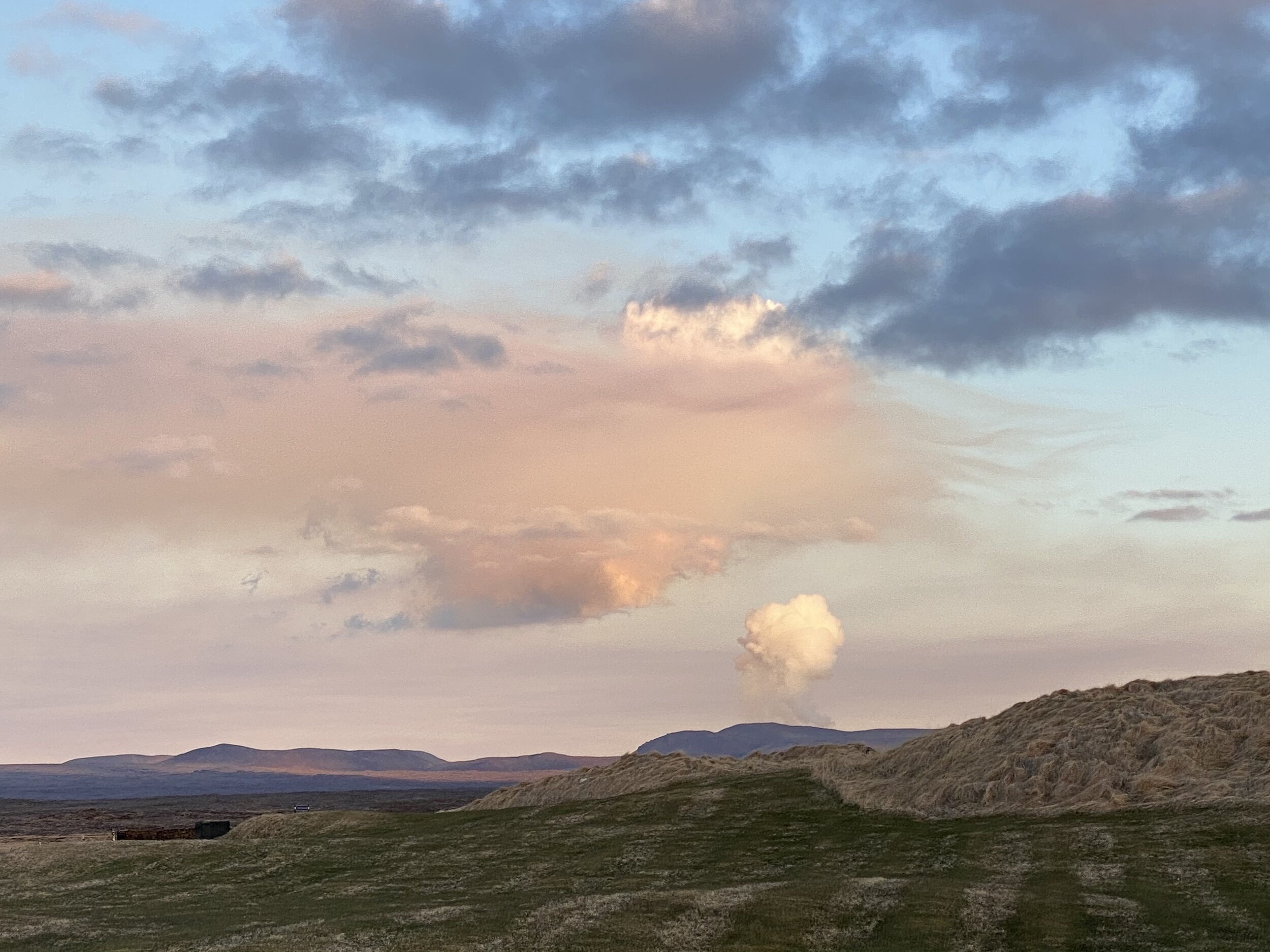Volcano sunset
Eruption cloud from our kitchen window, about 7 miles from Fagardalsfjall.
We arrived early Tuesday morning at Keflavik and were efficiently processed through customs, vaccination papers, citizenship, etc. all checked through with our pre-registration bar code. The next stop was a COVID-19 swab of the throat and nasal passages, again efficiently done. At that point, we were directed to quarantine for 24 hours or until we received a notice that our tests were negative. We never received the notice, so we hung out at our beautiful VRBO cottage on the Reykjanes peninsula with views of the eruption cloud , 7 miles away, from the kitchen window. We stayed awake for sunset over the lighthouse at about 10:30 p.m., tried our best to keep our eyes open until dark so we could see the eruption cloud glowing from the intermittent bursts of lava.
Sunset over the lighthouse Reykjanes Peninsula
The eruption site is the Fagardalsfjall mountain (meaning fair-valley-mountain), but also called Gelingsgadalsgos. The town of Grindavik held a contest in April to name the eruption and the lava field. I think that’s a very good idea. The multiple and difficult to pronounce names make it difficult to promote to tourists. On the other hand, Icelanders can make anything a selling point - I have a mug from the 2010 eruption of Eyjafjajokull that says “What’s so hard about Eyjafjajokull?” I tried to used Fagardalsfjall as a password for my new MacBook Pro computer (with the M1 chip - blazingly fast!) but I kept misspelling it and decided that a password that kept me out was probably very effective, but not very practical.
The property where the eruption is taking place is owned by about 20 private owners and is up for sale. The realtor has called it “the hottest property on the island” because of the degree of interest. Scientists have said the eruption may go on for years, so Icelanders are seeing potential as a spectacularly profitable tourism venue just twenty minutes from the airport. Already package tours are available to see the eruption and soak in the Blue Lagoon Spa as a stopover to Europe or a solo trip. Soon you may have to pay a fee to go see the eruption.
There hasn’t been an eruption on the Reykjanes peninsula for over 800 years. The last one took place in the 12th century when they were naming the mountain and probably not thinking about monetizing its eruptions. The Fagardalsfjall volcano has been dormant for 6,000 years. Although Iceland has an eruption on average every five years, many are in much less accessible regions of the country. The magma that is erupting here is coming from a depth of 10-12 miles in the earth - a very deep source indeed. They estimate that 25% of the Icelandic population has already come to see the eruption. This is a fissure eruption, relatively safe to hike in or fly over, and often referred to as a “tourist eruption” in this country.
Over my lifetime of visiting volcanoes, I’ve gravitated towards tourist eruptions. Perhaps that’s why at my age, approaching 70 this year, I’m still around to tell you about them. The explosive pyroclastic flows (think Mt. St. Helens, Mt. Unzen, Pinatubo, etc.) are likely to kill you if you get too close. I’ve always admired the scientists Maurice and Katia Krafft, who flew around the world photographing, writing about, and studying volcanoes. They were killed in 1991 in the Mt. Unzen eruption when a pyroclastic flow separated so that gasses went uphill to a ridge where the scientists and about 40 journalists thought they might safely view the eruption. All 41 were wiped out.
Lesson for the day: be safe. Visit safetravel.is if you plan to go. They have daily updates on the eruption.

